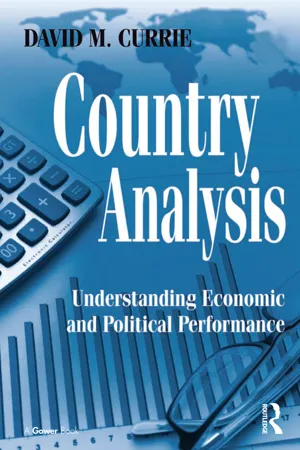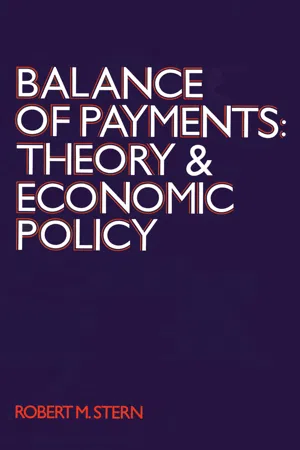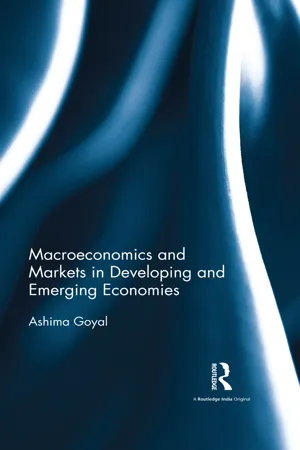BOP Financial account
The Balance of Payments (BOP) financial account records a country's international transactions involving financial assets and liabilities. It includes foreign direct investment, portfolio investment, financial derivatives, and other investments. The BOP financial account is a key component of the overall balance of payments, providing insights into a country's financial relationships with the rest of the world.
5 Key excerpts on "BOP Financial account"
- Linda L. Lowry(Author)
- 2016(Publication Date)
- SAGE Publications, Inc(Publisher)
...Balance of Payments Balance of Payments Justyna Majewska Justyna Majewska Majewska, Justyna 124 127 Balance of Payments Justyna Majewska Balance of payments (BOP) is a system of accounts that is a summary statement of all international transactions between the residents of one nation and the residents of other nations over a specified period of time that refer to the exchange of all goods, services (including travel and tourism), foreign aid, capital loans, income, foreign direct investments, short-term capital flows, and financial transfers coming in and going out, and the interrelations underlying all these items. The BOP records inflows of currency from nonresidents as well as payments of residents to nonresidents (outflows of currency) having to do with international trade transactions undertaken by these entities in a period of a year or a quarter. Hereby, the BOP becomes a source of information, aggregated into a few major categories, on the foreign activity of residents and the domestic activity of nonresidents. Analyzing the BOP allows one to recognize the types of transactions that determine the flows of money, goods, and services between countries and to understand the nature of international relations of the economy. Hence, the external determinants of developments on the domestic financial market, foreign exchange, and the real economy become more evident. The information contained in the BOP is useful in assessing the international competitiveness of the economy and its sensitivity to the economic turmoil in the world. Thus, the main purpose of the BOP is to inform the government of the international position of the nation and to help it in its formulation of monetary, fiscal, and trade policies. The Structure of the Balance of Payments The sources of money inflow and outflow are aggregated in the BOP in two main groups of transactions...
- eBook - ePub
Country Analysis
Understanding Economic and Political Performance
- David M. Currie(Author)
- 2016(Publication Date)
- Routledge(Publisher)
...CHAPTER 7 Evaluating International Transactions: The Balance of Payments People have traded for thousands of years, and they have traded across borders since countries have existed. However, the practice of recording international transactions from a country perspective is a more recent development. It wasn’t until National Income Accounting was developed during the first half of the twentieth century that a systematic approach to organizing and recording domestic and international transactions was created. The Balance of Payments (BoP) is the accounting record of transactions between a country and other countries. As with all accounting systems, judgments must be made about defining terms, classifying transactions, and standardizing results. The International Monetary Fund leads the effort toward standardizing accounting practices for international transactions. The IMF periodically issues guidelines and encourages countries to conform to the guidelines, but because individual countries prepare the raw data, the data are only as reliable as the individuals and governments preparing them. BoP accounting is an evolutionary process. The standards that apply today are not the standards that applied two decades ago, and they probably will not be the standards that will apply two decades hence. In fact, the IMF proposed standards in the early 1990s that are just now being implemented in each nation’s national accounting system, so there is a possibility of overlap and confusion when discussing accounting aspects of the BoP. Fortunately, interpreting the results is not as fluid as the underlying data, so there is some degree of consistency in interpretation...
- eBook - ePub
Balance of Payments
Theory and Economic Policy
- Robert Stern(Author)
- 2017(Publication Date)
- Routledge(Publisher)
...1 Balance-of-Payments Concepts and Measurement Our concern in the present chapter is the arrangement and interpretation of balance-of-payments information for purposes of economic analysis and policy assessment. Balance-of-payments accounting is illustrated briefly in the appendix to this chapter. Those interested in greater detail, especially on matters related to accounting, are advised to consult specialized sources. 1 Balance-of-Payments Concepts It is appropriate to begin by a definition : the balance ofpayments is a summary statement of all economic transactions between the residents of one country and the rest of the world, covering some given period of time. Like many definitions, this one requires clarification, especially with respect to the coverage and valuation of economic transactions and the criteria for determining residency. The coverage of economic transactions refers to both commercial trade dealings and noncommercial transfers, which may or may not be effected through the foreign exchange markets and which may not be satisfactorily recorded because of inadequacies in the system of data collection. Particularly difficult questions of valuation are posed by noncommercial transactions and by transactions that take place between domestic and foreign-based units of individual corporations. The determination of residency should ordinarily not be difficult, but even here questions may arise concerning the treatment of overseas military forces and embassies, corporate subsidiaries, and international organizations. 2 Transactions are recorded in principle on a double-entry bookkeeping basis. Each transaction entered in the accounts as a credit must have a corresponding debit and vice versa. The distributions commonly made in classifying the various accounts can be seen from the schematic balance of payments represented in Table 1.1 and from the illustrative transactions recorded in the appendix to this chapter...
- eBook - ePub
- Ayse Evrensel(Author)
- 2013(Publication Date)
- For Dummies(Publisher)
...In other words, the MBOP views the subject of exchange rate determination from the point of view of international investors. In this chapter, you’ll imagine investors trying to decide between two securities denominated in two different currencies. The answer to the question “How will they decide?” lies in the center of the MBOP’s method of exchange rate determination. As investors favor one country’s security over the other country’s security, their decision affects the exchange of currencies and therefore leads to appreciation or depreciation of currencies. You may be asking what the name Monetary Approach to Balance of Payment suggests. Here I break it down into two parts: Monetary: The term Monetary in the name of this particular approach to exchange rate determination reveals interesting insights regarding the decision-making process of international investors. It means that investors keep an eye on the interest rates in the money markets of two countries. Additionally, because changes in monetary policies of these countries change their interest rates, investors pay attention to changes in monetary policies of these countries as well. Balance of Payments: The Balance of Payments (BOP) indicates an account that keeps track of a country’s transactions with other countries. The BOP captures trade in goods and services as well as the flow of funds (investment, loans, and so on) between the home country and the rest of the world. Historically, the Monetary Approach to Balance of Payments indicated the theory that explains the effects of the changes in a country’s money market on its BOP or its transactions with the rest of the world...
- Ashima Goyal(Author)
- 2016(Publication Date)
- Routledge India(Publisher)
...These form part of GNS. The basic macroeconomic identity reflects flow variables. For example, savings is the share of income, a flow, which is not consumed. The manipulations of this identity to give different measures of the CA are also all flow variables. Therefore, the current account records income flows. But a CAD in any year adds to debt, which is a stock. While the CA records income flows that are part of current income, the financial accounts record financial flows or acquisition of financial assets that help finance a current account deficit, or else invest a current account surplus, leading to a change in assets. A change in official assets, the reserves of foreign currency held by the Central Bank (CB), is a balancing item. So, a fourth definition of the CAD is the acquisition of domestic assets by foreign residents minus domestic residents’ acquisition of foreign assets (including official reserves). The flow of these assets themselves is recorded in the financial account. While the CA records the sales and purchases of goods and services that generate income, the financial account records the sales and purchases of assets that change the stock of wealth. The wealth itself, or the liabilities and asset position of a nation, is recorded in a separate set of accounts known as the international investment position (Table 2.4 gives this for India). The fundamental equation of the BOP is the current account plus the financial account and capital account must sum to zero or the current and capital account must equal the financial account in the new definition. 5 This follows, since each transaction recorded in the double-entry BOP system generates an offsetting transaction. In the BOP, receipt from foreigners is a credit and enters with a positive sign; payment to foreigners is a debit and enters with a minus sign. Since it is a double-entry account, each transaction generates one credit and one debit entry. Under barter, imports would equal exports...




